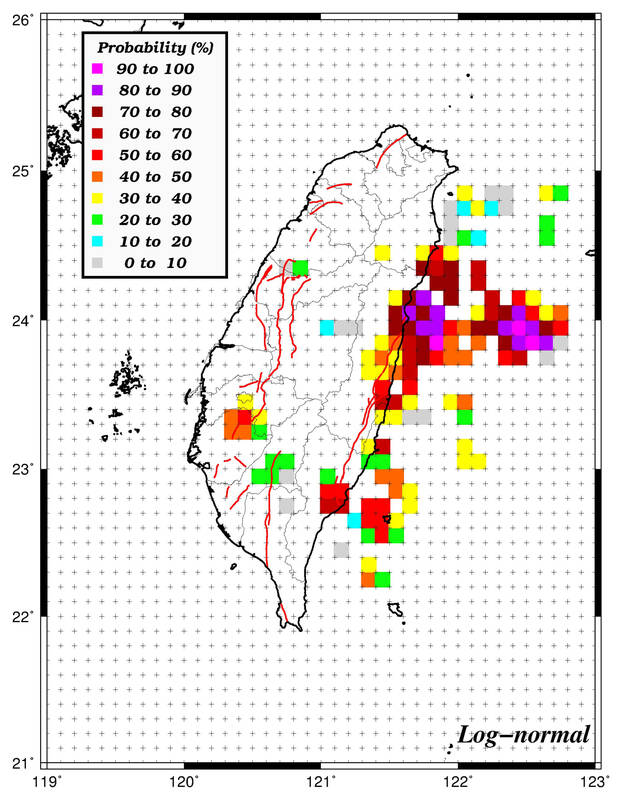There are three or four high-risk faults in the populous Chianan Plain (嘉南平原) beneath Chiayi County and Tainan, the Central Weather Bureau (CWB) said yesterday, declining to provide details to avoid causing panic.
About 10 faults of various lengths are in the area, but only three or four of them are considered dangerous, CWB Seismological Center Director Chen Kuo-chang (陳國昌) said.
As no dislocation has been recorded from the faults for a long time, their seismic activity should be monitored closely because the accumulated energy could be high, he said.

Photo courtesy of the Central Weather Bureau
However, there is no ideal way of predicting earthquakes, and even calculating the long-term probability of a quake can be difficult, he said.
Former CWB director-general Shyn Tzay-chyn (辛在勤) told reporters at a news conference in Taipei that the Meishan (梅山), Chuko (觸口), Baihe (白河) and Sinhua (新化) faults in the Chianan Plain have long been considered potentially hazardous faults, and some seismologists believe that the Muchiliao (木屐寮) fault is a high-risk feature.
The risk levels of the faults have been known for nearly 50 years, but there was no reason to alarm people by discussing them, he said.
The latest research by the Central Geological Survey revealed 36 active faults nationwide, with seismologists warning about the Shanchiao fault (山腳斷層) beneath the Taipei basin.
Chen said that the risk of Shanchiao causing large earthquakes is quite low, adding that the fault has not caused earthquakes or rifts, or dislocated in the past century.
Some people are concerned that the Chishang fault (池上斷層) might dislocate, as the hypocenter of the main shock of Sunday’s magnitude 6.8 earthquake was near it.
“It is not certain” whether dislocation would occur, Chen said, adding that “only time will tell.”
Regarding this week’s series of earthquakes, Chen said that the temblors should gradually stop, with 164 earthquakes recorded as of 9:30am yesterday.
Aftershocks are expected to decrease in magnitude and frequency over the next four weeks, with a slim chance of a magnitude 5 quake today, he said.
The center has not yet identified an active fault linked to the quakes, the main shock of which was the strongest onshore earthquake to hit Taitung since 1973.
Since neither the main shock nor the foreshocks that reached magnitude 6 occurred along Chishang’s fault lines, it is certain that the quakes were not triggered by the Chishang fault system as some seismologists suggested, Chen said.
In response to speculation that the source of the quakes could be a blind active fault under the Central Mountain Range, Chen said no active fault line under the principal mountain range on Taiwan had been discovered, citing Central Geological Survey data from last year.
The survey would conduct further studies to determine if the Central Mountain Range fault is active but blind, which is still under debate in the seismology community, he added.

Police have issued warnings against traveling to Cambodia or Thailand when others have paid for the travel fare in light of increasing cases of teenagers, middle-aged and elderly people being tricked into traveling to these countries and then being held for ransom. Recounting their ordeal, one victim on Monday said she was asked by a friend to visit Thailand and help set up a bank account there, for which they would be paid NT$70,000 to NT$100,000 (US$2,136 to US$3,051). The victim said she had not found it strange that her friend was not coming along on the trip, adding that when she

TRAGEDY: An expert said that the incident was uncommon as the chance of a ground crew member being sucked into an IDF engine was ‘minuscule’ A master sergeant yesterday morning died after she was sucked into an engine during a routine inspection of a fighter jet at an air base in Taichung, the Air Force Command Headquarters said. The officer, surnamed Hu (胡), was conducting final landing checks at Ching Chuan Kang (清泉崗) Air Base when she was pulled into the jet’s engine for unknown reasons, the air force said in a news release. She was transported to a hospital for emergency treatment, but could not be revived, it said. The air force expressed its deepest sympathies over the incident, and vowed to work with authorities as they

A tourist who was struck and injured by a train in a scenic area of New Taipei City’s Pingsi District (平溪) on Monday might be fined for trespassing on the tracks, the Railway Police Bureau said yesterday. The New Taipei City Fire Department said it received a call at 4:37pm on Monday about an incident in Shifen (十分), a tourist destination on the Pingsi Railway Line. After arriving on the scene, paramedics treated a woman in her 30s for a 3cm to 5cm laceration on her head, the department said. She was taken to a hospital in Keelung, it said. Surveillance footage from a

INFRASTRUCTURE: Work on the second segment, from Kaohsiung to Pingtung, is expected to begin in 2028 and be completed by 2039, the railway bureau said Planned high-speed rail (HSR) extensions would blanket Taiwan proper in four 90-minute commute blocs to facilitate regional economic and livelihood integration, Railway Bureau Deputy Director-General Yang Cheng-chun (楊正君) said in an interview published yesterday. A project to extend the high-speed rail from Zuoying Station in Kaohsiung to Pingtung County’s Lioukuaicuo Township (六塊厝) is the first part of the bureau’s greater plan to expand rail coverage, he told the Liberty Times (sister paper of the Taipei Times). The bureau’s long-term plan is to build a loop to circle Taiwan proper that would consist of four sections running from Taipei to Hualien, Hualien to